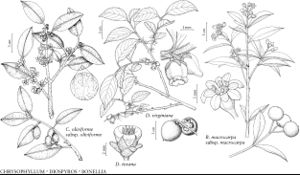Difference between revisions of "Chrysophyllum"
Sp. Pl. 1: 192. 1753.
Gen. Pl. 5, 88. 1754 ,.
FNA>Volume Importer |
imported>Volume Importer |
||
| (3 intermediate revisions by 2 users not shown) | |||
| Line 47: | Line 47: | ||
|publication year=1753; | |publication year=1753; | ||
|special status= | |special status= | ||
| − | |source xml=https:// | + | |source xml=https://bitbucket.org/aafc-mbb/fna-data-curation/src/2e0870ddd59836b60bcf96646a41e87ea5a5943a/coarse_grained_fna_xml/V8/V8_507.xml |
|genus=Chrysophyllum | |genus=Chrysophyllum | ||
}}<!-- | }}<!-- | ||
-->[[Category:Treatment]][[Category:Sapotaceae]] | -->[[Category:Treatment]][[Category:Sapotaceae]] | ||
Latest revision as of 22:44, 5 November 2020
Trees. Stems unarmed, densely hairy to glabrate. Leaves persistent, alternate; stipules absent; petiole present; blade: base cuneate to rounded, apex acute to acuminate [rounded or emarginate], surfaces densely hairy [glabrous] abaxially, usually glabrous adaxially. Inflorescences fascicles or solitary flowers. Flowers: sepals 4–5[–6] in 1 whorl, imbricate, abaxially densely hairy; petals (4–)5(–6)[–8], greenish white or greenish yellow, sericeous adaxially, lobes undivided, equaling or shorter than [exceeding] corolla tube; stamens 4–5[–8], distinct; staminodes absent [present]; pistil 3–5(–6)[–12]-carpellate; ovary 3–6[–12]-locular, densely hairy; placentation axile. Berries purple to black [yellow, orange, red, brown, green], ellipsoid to ovoid, glabrous [hairy]. Seeds 1[–5], brown, laterally compressed; hilum narrowly ovate to obovate; embryo vertical; endosperm present. x = [12, 13, 14,] 26.
Distribution
Fla., Mexico, West Indies, Central America, South America, Asia, Africa, Indian Ocean Islands (Madagascar), Australia, nearly worldwide in tropics and subtropics.
Discussion
Species ca. 70 (1 in the flora).
Most species of Chrysophyllum are located in the Neotropics. Species with edible fruits are numerous; C. africanum A. de Candolle, the “odara pear” or “African star apple,” is sold commercially. Chrysophyllum cainito Linnaeus, the star-apple, is cultivated for its foliage and fruit in south Florida. The star-apple is distinguished by having larger (3 cm in diameter), several-seeded fruits. Other species have valuable woods that are used in various ways.
Selected References
None.
